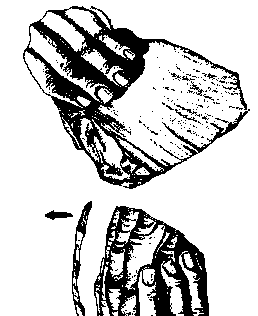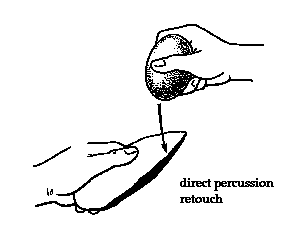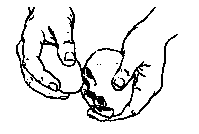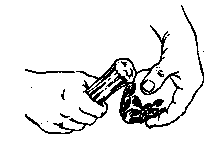

Direct percussion or simple percussion takes place when the hammer, which can be hard or soft, is applied directly to the piece being worked. This does not necessarily result in rough or crude flaking. As has been demonstrated by experimentation a skilled knapper can produce well-formed and even elaborate artifacts using this production technique (example, Newcomer 1975: 99-101).


Indirect percussion is a technique which involves striking a punch-like object with a hammer or percussor. The tip of the punch is placed on the platform of the core at the point intended to receive the blow. It is important to keep the core immobile during the striking process. When using this technique it is also advisable to prepare the core platform to prevent the punch from slipping.
"In indirect percussion a punch of antler or wood or other hard material is placed on the platform and struck with a hammer, instead of striking the stone directly with the hammer. This allows the force to be directed very precisely, an important factor in making blades, which require a carefully prepared core with an even platform and regular ridges for the blades to follow." Whittaker 1994: 33.


Pressure flaking is the process of forming an artifact by removing surplus material, in the form of chips and flakes, by a pressing force rather than by percussion (Crabtree 1982:49).
"Pressure flaking involves removing flakes from the edge of a tool by pressing against it, usually with an antler or bone tool, instead of striking it. Pressure flaking is generally used for the final retouch on tools that were begun by other techniques." (Whittaker 1994: 33).

"Hard hammer percussion - that is, striking the tool with another stone to remove flakes." (Whittaker 1994: 27).
The following are indications of the use of a hard hammer or percussor (see Ohnuma & Bergman 1983):

The following are indications of the use of a soft hammer or percussor: Owen (1988: 218; see Ohnuma & Bergman 1983).

It should also be noted that a hard hammer can become softened from repeated use until it has the same qualities as a soft hammer.
©
Internet Archaeology
Last updated: Thu Mar 20 1997